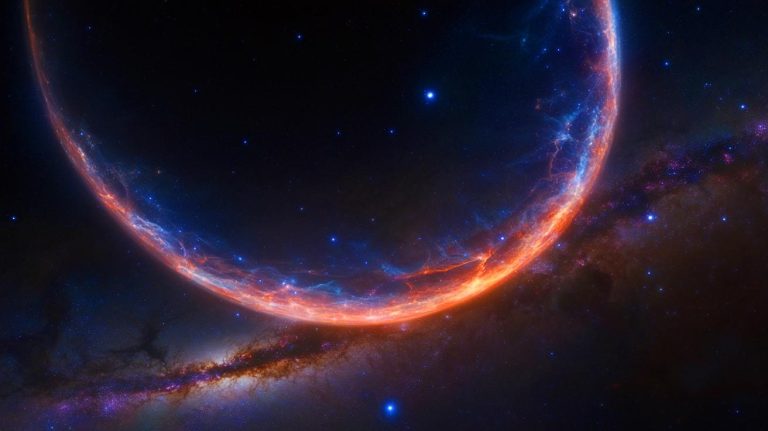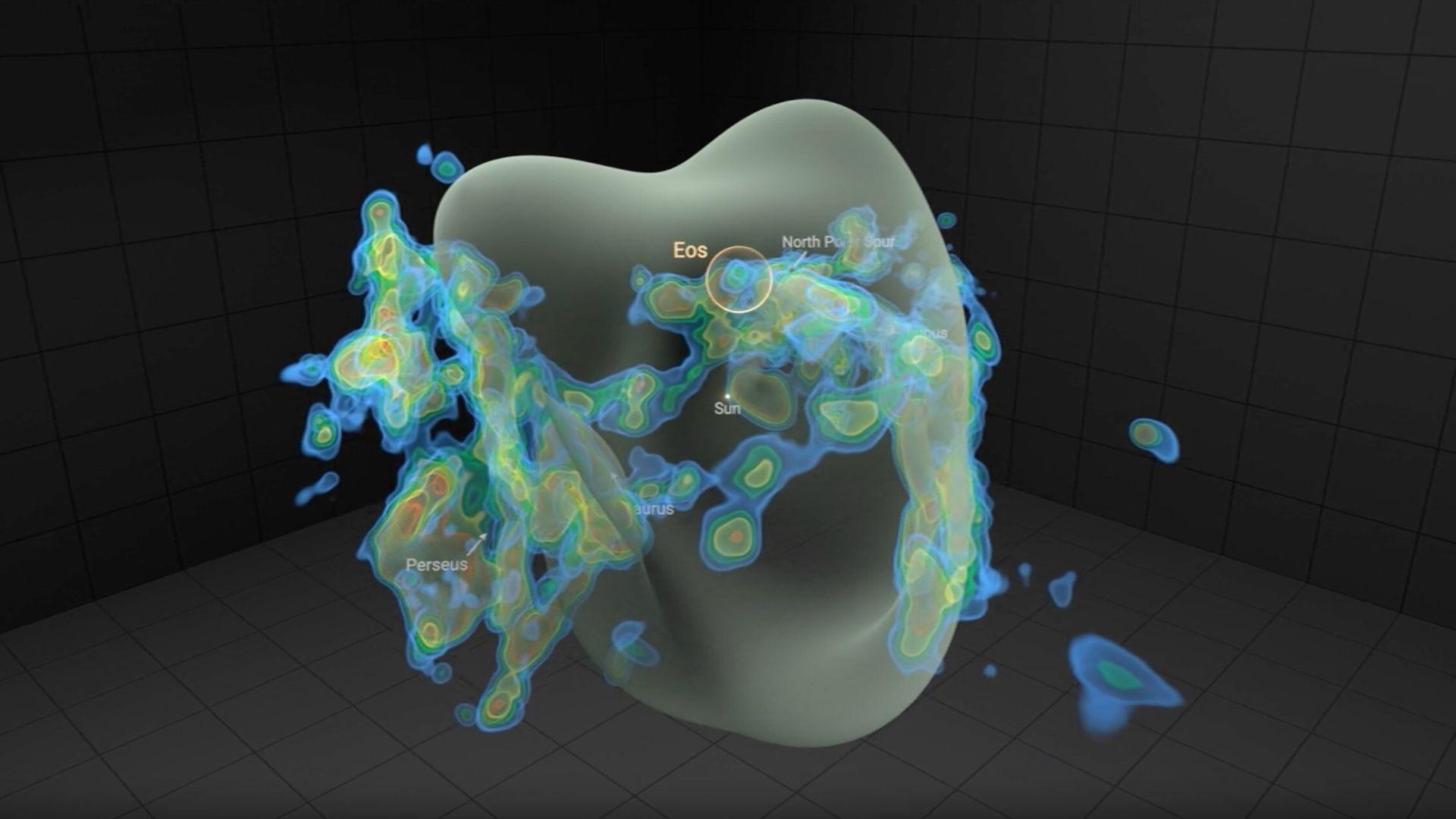| IN A NUTSHELL |
|
In the vast expanse of the cosmos, the discovery of hidden celestial structures often transforms our understanding of the universe. Recently, astronomers unveiled Eos, a gigantic molecular cloud lurking just 300 light-years away from Earth. Despite its proximity and size, Eos remained hidden until now, offering a new perspective on the cosmic recycling of matter that fuels star and planet formation. This discovery marks a significant milestone in astronomical research, showcasing the relentless pursuit of knowledge that drives scientists to explore the unseen realms of our universe.
The Enormity of Eos
Eos, named after the Greek goddess of dawn, is an immense crescent-shaped molecular cloud composed primarily of hydrogen gas. Spanning approximately 100 light-years, it is one of the largest known structures in the sky. To illustrate, its width is equivalent to about 40 Earth moons lined up side by side. Despite its colossal size, Eos had eluded detection due to its low carbon monoxide (CO) content, a chemical signature typically used by astronomers to identify molecular clouds. The revelation of Eos challenges previous assumptions about the visibility and detectability of such clouds, highlighting the need for innovative approaches in astronomical observations.
The discovery was led by Blakesley Burkhart, an associate professor at Rutgers University. Burkhart’s team employed a novel method, detecting Eos through the fluorescent glow of hydrogen molecules. This breakthrough technique promises to uncover many more CO-dark clouds, potentially reshaping our understanding of the distribution and abundance of molecular hydrogen in the galaxy.
A Window into Cosmic Recycling
Molecular hydrogen is the most abundant substance in the universe, playing a crucial role in star and planet formation. By studying hydrogen-filled clouds like Eos, astronomers can better gauge the amount of material available for these processes. The discovery of Eos provides a unique opportunity to observe the cosmic recycling of matter up close. As hydrogen in these clouds collapses under gravity, it can form stars and planetary systems, making molecular clouds the nurseries of the cosmos.
The findings were published in the journal Nature Astronomy, marking a significant contribution to the field. By identifying hidden reservoirs of hydrogen, astronomers can refine models of star formation and improve our understanding of the Milky Way’s structure. This research underscores the importance of exploring our galactic neighborhood and the potential for new discoveries that challenge existing paradigms.
The Role of the North Polar Spur
Eos’s distinctive crescent shape is influenced by its interaction with the North Polar Spur, a vast region of ionized gas extending from the Milky Way’s plane toward the northern celestial pole. This colossal feature has likely shaped Eos through energy and radiation driven by past supernovas or stellar winds. The alignment of Eos with the North Polar Spur suggests a dynamic relationship between these structures, offering insights into the forces that sculpt molecular clouds.
Simulations of Eos’s evolution indicate that its molecular hydrogen reservoir is gradually torn apart by incoming photons and cosmic rays. This process suggests that Eos may evaporate in about 6 million years, highlighting the transient nature of such cosmic phenomena. The study of Eos and its interactions with the North Polar Spur provides a glimpse into the complex interplay of forces that govern the life cycles of molecular clouds.
Future Explorations and Open Questions
Building on the discovery of Eos, Burkhart and her colleagues are developing a mission concept for a NASA spacecraft named after the cloud. The proposed Eos space telescope would observe in far-ultraviolet wavelengths to measure molecular hydrogen content across the Milky Way. This ambitious project aims to conduct a comprehensive census of the formation and destruction of molecular hydrogen gas, offering new insights into the galaxy’s evolution.
While the discovery of Eos is a significant achievement, many questions remain unanswered. The cloud’s potential for star formation, its interactions with surrounding structures, and its ultimate fate are subjects of ongoing research. As astronomers continue to explore the cosmos, the discovery of Eos serves as a reminder of the vastness and complexity of the universe. What other hidden wonders await our discovery, and how will they reshape our understanding of the cosmos?
Did you like it? 4.4/5 (27)











Wow, Eos sounds like the perfect hiding spot for a space hide-and-seek game! 🌌
I can’t believe I never knew that our moon is 2.5 light-years in diameter! Lol
How did astronomers miss something so big for so long? 🤔
Such a cool find! Can’t believe it was right under our noses the whole time.
The Eos space telescope sounds like a game changer for astronomy. 🚀
Thank you for the informative article! It’s fascinating how new techniques keep revealing the universe’s secrets.
The article mentions the North Polar Spur; what exactly is that?
It’s amazing how the universe keeps surprising us with these hidden giants! 😮
Fluorescent glow of hydrogen? Sounds like something from science fiction!
This is why we need to invest more in space exploration. So much to discover! 🌠
How does the discovery of Eos impact our understanding of star formation?
Imagine the view from Eos! I bet it’s breathtaking! 😊
Great article, but I wish there were more images included to visualize Eos.
So Eos was hiding due to low CO content? Clever cloud! 😏
This is a huge win for the scientific community. Kudos to the team involved!
Can Eos actually be seen with the naked eye or only through telescopes?
What an exciting time to be alive with all these discoveries happening! 🌌
Why did it take so long to spot Eos? Are our detection methods that outdated?
It’s so exciting to think about what new technologies will reveal next!
Could Eos potentially facilitate new star systems? Curious about its potential! 🤓
I love how discoveries like this remind us of how little we know about our universe.
Does this discovery have any implications for potential interstellar travel?
Does this mean there could be more hidden clouds like Eos out there?
Would love to see a simulation of Eos’s lifecycle and how it interacts with the North Polar Spur!
Hope the Eos space telescope mission gets the green light soon. The possibilities are endless!
So, are we looking at a potential new star nursery with Eos?
Really interesting read! Keep up the great work with these articles.
Can’t wait for more updates on the Eos mission. This is exciting! 🌌
Does this change our understanding of how common molecular clouds are in the Milky Way?
Big deal, or should I say “giant cloud” deal? 😂
What other hidden wonders could be lurking in our galaxy? The universe is full of surprises!
Are there any known threats from a cloud like Eos to our solar system? 🤔